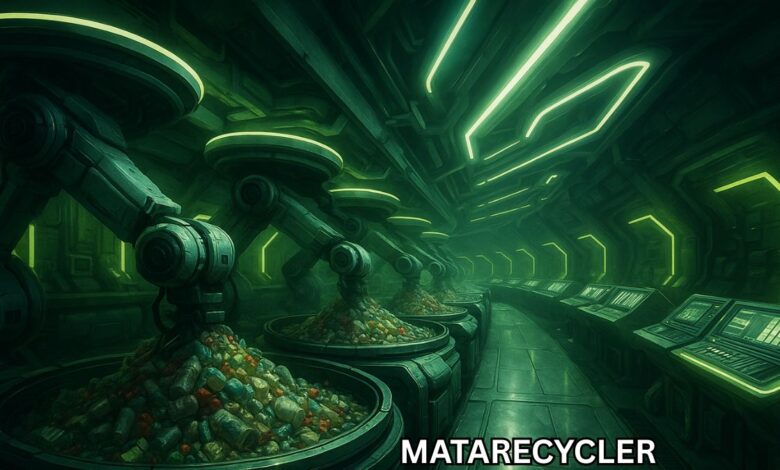MataRecycler: The Smart Recycling Revolution Transforming Global Waste Management

Every year, the world produces more than 2 billion tonnes of municipal solid waste, and that figure is expected to rise by almost 70 percent by 2050. Despite growing environmental awareness, only a fraction of this waste is properly recycled. Most cities still rely on outdated collection systems, underfunded recycling facilities, and unverified data on what actually gets recovered.
Enter MataRecycler, a platform that bills itself as “the intelligent recycling system for a circular future.” Combining artificial intelligence, robotics, and cloud analytics, it aims to modernize the way communities, companies, and governments sort, track, and monetize recyclable materials.
While still in its early stages of widespread deployment, MataRecycler has already become a buzzword in sustainability circles. Advocates see it as the missing link between digital technology and real-world environmental impact.
The Concept Behind MataRecycler
At its core, MataRecycler is not just a machine—it’s an ecosystem. The platform merges hardware, software, and human engagement to improve every stage of the recycling process.
- Smart Hardware – Sensor-equipped bins, conveyor-mounted cameras, and robotic sorters capable of distinguishing materials based on color, shape, and texture.
- AI-Driven Software – Machine-learning algorithms identify and classify waste in real time, measure contamination rates, and feed data into centralized dashboards.
- Analytics & Insights – A cloud-based portal that tracks performance metrics: how much waste is collected, what percentage is recyclable, and how efficient each route or facility is.
- User Engagement Tools – Apps for households or employees that offer tips, reminders, and even reward systems for responsible recycling behavior.
This multi-layered approach means that MataRecycler doesn’t just automate sorting—it creates a feedback loop where every participant, from citizens to plant managers, can see the impact of their actions.
How It Works: From Bin to Dashboard
1. Smart Collection
The journey begins at the point of disposal. MataRecycler bins are embedded with weight sensors, fill-level detectors, and sometimes even bar-code scanners. When users deposit materials, the bin can recognize types of waste—plastic bottles, paper, cans—and issue gentle alerts if the wrong item is dropped in.
In urban or campus settings, these bins are connected via IoT networks. Once full, the system automatically notifies collection teams, ensuring optimal routing and minimizing unnecessary fuel use.
2. Sorting and Recovery
When trucks deliver materials to sorting facilities, MataRecycler’s high-speed cameras and AI models come into play. The system identifies recyclable materials with a precision level that early reports estimate at over 90 percent accuracy under optimal lighting conditions.
Some setups include robotic arms capable of separating materials faster than manual sorters, reducing labor strain while improving consistency.
3. Real-Time Analytics
All collected data—material types, contamination levels, equipment status—is uploaded to a secure cloud platform. Waste-management operators and local governments can visualize trends, compare performance across districts, and generate automated sustainability reports.
4. Feedback and Education
Unlike traditional recycling infrastructure, MataRecycler includes a social layer. Through a companion mobile app, residents can track how well they are sorting their waste, compete with neighbors or offices, and receive tangible rewards such as discount vouchers or carbon-credit points.
Tackling the Big Recycling Challenges
MataRecycler directly targets four systemic issues that have long plagued waste management:
1. Contamination
Contamination—when non-recyclables enter the recycling stream—remains the biggest reason loads are rejected. AI-based recognition helps prevent this at the source, and real-time alerts allow correction before collection.
2. Labor Shortages
Recycling facilities often struggle to maintain staff for tedious manual sorting lines. MataRecycler’s automation supplements human workers, allowing them to focus on higher-value tasks like maintenance and quality control.
3. Data Transparency
Governments and private recyclers often rely on estimations rather than verified data. The platform’s sensors and dashboards deliver real-time visibility into how much waste is collected, processed, and diverted from landfills.
4. Public Engagement
Most recycling programs fail not because of lack of infrastructure but because of low participation. MataRecycler gamifies participation, turning recycling into a measurable, rewarding daily habit.
Where It’s Being Deployed
Urban Pilots
Several cities in Asia and Europe have begun small-scale pilots, particularly in high-density residential zones. These pilots integrate MataRecycler bins with municipal waste-collection trucks, feeding performance data directly into local sustainability dashboards.
Universities and Corporate Campuses
In controlled environments—where waste sources are predictable—MataRecycler’s impact is easier to measure. A university campus can compare dormitories, while a corporate complex can reward departments that reduce contamination rates.
Material Recovery Facilities (MRFs)
At industrial scales, MataRecycler’s sensors and AI assist with sorting plastic resins (PET, HDPE, PP) and metals, improving yield and throughput while lowering rejection rates.
E-Waste Management
Given its ability to trace materials, the system also finds relevance in electronic waste (e-waste)—a sector that demands both efficiency and verified downstream processing. The platform can track each item’s journey from collection to certified recycler.
The Technology Under the Hood
Artificial Intelligence
At the heart of MataRecycler lies computer-vision technology trained on millions of images of recyclables. Using deep-learning models, it identifies objects and assigns them a probability label (e.g., 92 % chance “HDPE bottle”).
Over time, the AI improves its accuracy through reinforcement learning—analyzing feedback from manual checks and new waste types introduced into the system.
Internet of Things (IoT)
Every bin, truck, and conveyor module can act as a sensor node, transmitting data about fill levels, temperatures, and even vibration anomalies (which could indicate maintenance needs).
Cloud & Edge Computing
While AI inference often happens on-device (edge processing) to reduce latency, aggregated analytics occur in the cloud. This architecture allows municipalities or corporations to monitor dozens of facilities in real time.
Robotics Integration
In larger facilities, MataRecycler can connect with robotic arms capable of picking up to 60 items per minute. Paired with AI vision, these robots replace or supplement human sorting lines, improving safety and speed.
Economic and Environmental Impact
Operational Efficiency
By optimizing pickup routes and automating sorting, MataRecycler claims to cut operational costs by 15–25 percent compared to conventional recycling systems.
Higher Recovery Rates
Cleaner, better-sorted output increases the resale value of recovered materials, making recycling not only environmentally sound but economically viable.
Carbon Reduction
By reducing landfill waste and optimizing transportation, the system indirectly cuts greenhouse-gas emissions associated with waste decomposition and vehicle fuel use.
Job Creation
Contrary to fears of automation replacing humans, MataRecycler can create new skilled roles in AI maintenance, data analytics, and equipment management—modernizing the recycling workforce.
Business Model
The MataRecycler ecosystem operates on a “Technology-as-a-Service” model. Rather than selling bins outright, the company often provides hardware leases paired with subscription-based analytics software.
Revenue streams include:
- SaaS licensing for data dashboards and analytics.
- Hardware leasing for smart bins, sensors, and robotic units.
- Performance-based contracts, where cities pay per tonne of verified recycled output or contamination reduction achieved.
This hybrid model makes the platform scalable for both small municipalities and large industrial recyclers.
Barriers to Adoption
Despite its promise, MataRecycler faces challenges common to emerging cleantech:
- Cost of Entry – Smart bins and AI systems are more expensive upfront than conventional containers. Cost savings accumulate over time, but initial investment may deter smaller towns.
- Infrastructure Compatibility – Legacy waste-collection vehicles and sorting lines may require retrofitting to integrate MataRecycler’s technology.
- Data Privacy and Governance – With cameras and cloud analytics, questions arise about who owns and safeguards the collected data.
- Performance in Harsh Environments – Dust, poor lighting, and variable waste composition can reduce sensor accuracy.
- Need for Behavioral Reinforcement – Even the smartest system fails if users continue to dispose of waste incorrectly. Education and consistent community engagement remain critical.
The Broader Context: A Global Shift Toward Smart Waste
MataRecycler is part of a growing global movement where digitalization meets environmental policy. From Singapore’s “Smart Waste Management” pilot to Europe’s data-driven circular-economy mandates, cities are embracing technology to close the loop on materials.
The global smart-waste technology market, estimated at USD 2.5 billion in 2024, is projected to grow at more than 15 percent annually through 2030. MataRecycler positions itself at the intersection of this trend, targeting a space where sustainability and profitability overlap.
Future Outlook
Analysts expect the next stage of MataRecycler’s evolution to include:
- Blockchain-based tracking of recyclables for verified recycled-content claims.
- Integration with deposit-return schemes and carbon-credit systems.
- Expansion into developing economies, where the need for scalable, low-maintenance waste solutions is greatest.
- AI model sharing among partner facilities to continuously improve identification accuracy.
If these ambitions materialize, MataRecycler could emerge as a key component of the global circular economy.
Conclusion: Data Meets Sustainability
The promise of MataRecycler lies in its fusion of intelligence and infrastructure. By uniting physical collection systems with real-time analytics and citizen engagement, it represents a paradigm shift from waste management to resource management.
Whether it becomes a staple of future smart cities will depend on scalability, affordability, and the willingness of both governments and citizens to participate.
For now, MataRecycler stands as a symbol of what’s possible when environmental goals align with technological innovation—an ambitious, data-driven step toward cleaner cities and a more circular planet.
(FAQs)
1: What exactly does MataRecycler mean by “smart recycling”?
It refers to the use of AI, sensors, and data analytics to automatically identify, sort, and monitor recyclables while providing feedback to users and operators.
2: Is MataRecycler a machine or an app?
It’s both—and more. The ecosystem includes physical smart bins and sorting hardware, AI-driven software, and cloud-based analytics dashboards.
3: Can individuals use it at home?
Yes, in pilot cities residents can access a mobile app that tracks their household recycling performance, shows contamination alerts, and provides eco-points redeemable for rewards.
4: Does it actually improve recycling rates?
Early case studies suggest contamination reductions of up to 30 percent and recycling-rate increases of 20–40 percent in pilot programs. However, results vary based on local participation and infrastructure.
5: What kinds of materials can it recognize?
MataRecycler’s computer vision currently distinguishes common categories: plastics (PET, HDPE, PP), paper/cardboard, metals, glass, and some forms of e-waste.
For more celebrity updates, trending stories, and inspiring biographies, visit celebtoday.co.uk — your daily source for entertainment news and star insights!



